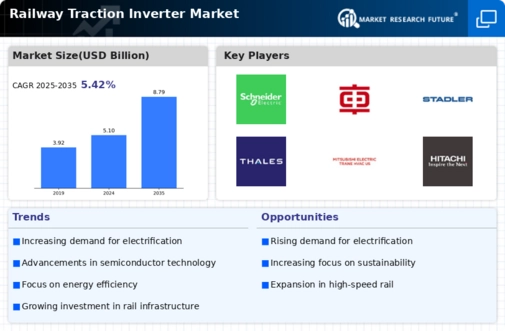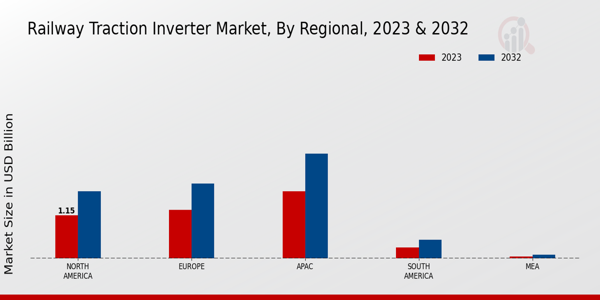Market Growth Charts
Government Initiatives and Funding
Government initiatives play a crucial role in shaping the Global Railway Traction Inverter Market Industry. Various countries are implementing policies and providing funding to promote the development of rail infrastructure. For example, the European Union has allocated substantial resources to enhance rail connectivity and sustainability. Such initiatives not only facilitate the adoption of advanced traction inverters but also encourage private investments in the sector. The expected compound annual growth rate of 5.08% from 2025 to 2035 indicates that government support is likely to sustain momentum in the market, fostering innovation and expansion.
Growing Demand for Electrification
The Global Railway Traction Inverter Market Industry is experiencing a notable increase in demand for electrification of rail networks. This shift is driven by the need for sustainable transportation solutions and the reduction of carbon emissions. Governments worldwide are investing in electrified rail systems, which are more energy-efficient compared to diesel alternatives. For instance, countries like Germany and Japan are expanding their electrified rail networks, contributing to the projected market value of 5.1 USD Billion in 2024. This trend is expected to continue, as electrification is seen as a key component in modernizing rail infrastructure.
Rising Urbanization and Population Growth
Urbanization and population growth are driving the demand for efficient public transportation systems, including rail networks. The Global Railway Traction Inverter Market Industry is poised to benefit from this trend, as cities expand and the need for reliable transit options increases. Countries with rapidly growing urban populations, such as India and China, are investing heavily in their rail infrastructure. This investment is expected to lead to a higher adoption rate of traction inverters, as they are essential for modern electric trains. The market's projected growth reflects the increasing focus on sustainable urban mobility solutions.
Focus on Energy Efficiency and Sustainability
The Global Railway Traction Inverter Market Industry is increasingly focused on energy efficiency and sustainability. Rail operators are under pressure to reduce energy consumption and minimize their environmental impact. Traction inverters play a vital role in achieving these goals by optimizing energy use in electric trains. As a result, there is a growing trend towards the integration of smart technologies that enhance energy management. This focus aligns with global sustainability goals, prompting investments in energy-efficient rail solutions. The market's growth trajectory suggests that this emphasis on sustainability will continue to shape industry developments.
Technological Advancements in Inverter Design
Innovations in inverter technology are significantly influencing the Global Railway Traction Inverter Market Industry. Advanced designs, such as silicon carbide (SiC) inverters, offer improved efficiency and performance. These technological advancements not only enhance energy conversion but also reduce the overall weight of traction systems, leading to better fuel efficiency and lower operational costs. As rail operators seek to upgrade their fleets, the adoption of these cutting-edge technologies is likely to drive market growth. The anticipated market expansion to 8.79 USD Billion by 2035 reflects the impact of these innovations on the industry.














